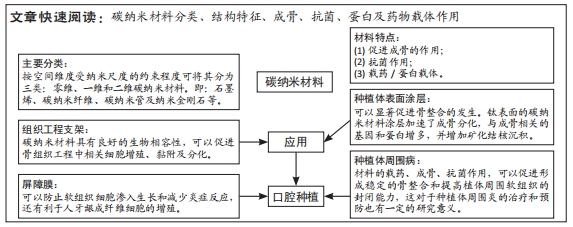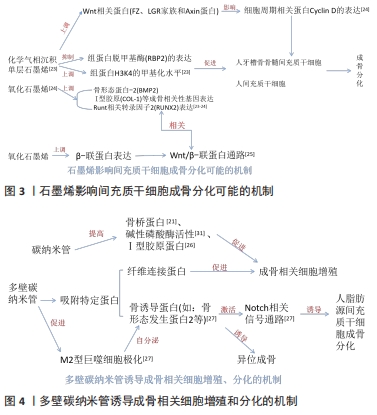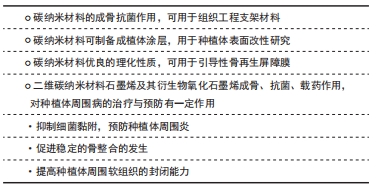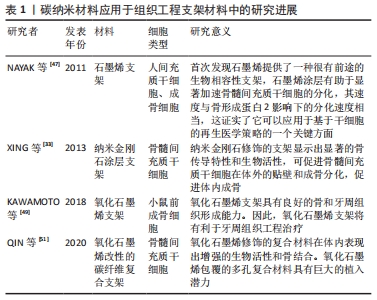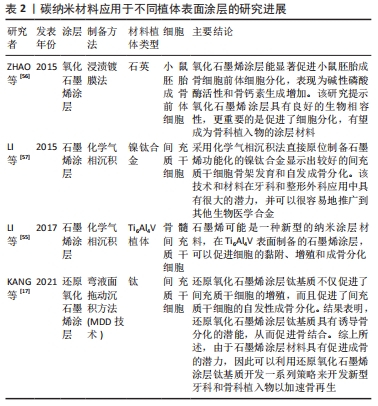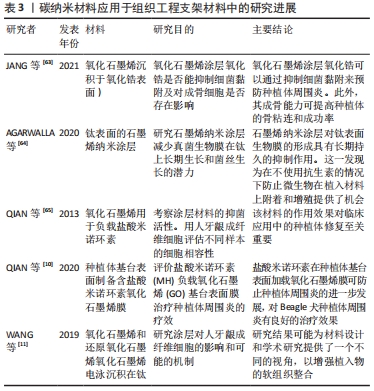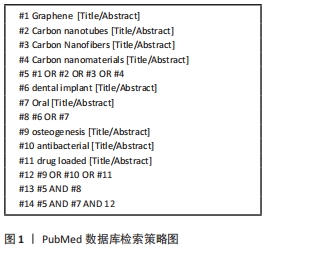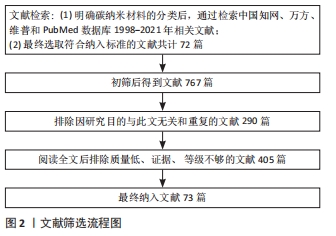[1] CHUNG C, KIM YK, SHIN D, et al. Biomedical applications of graphene and graphene oxide. Acc Chem Res. 2013;46(10):2211-2224.
[2] VENKATESAN J, PALLELA R, KIM SK. Applications of carbon nanomaterials in bone tissue engineering. J Biomed Nanotechnol. 2014;10(10):3105-3123.
[3] 张超,张利,刘兴华,等.碳纳米材料的抗菌性及在生物医学中的应用研究进展[J].材料导报,2020,34(S1):53-57.
[4] 刘宝林.口腔种植学[M].北京:人民卫生出版社,2010:18-27.
[5] LI Q, WANG Z. Involvement of FAK/P38 signaling pathways in mediating the enhanced osteogenesis induced by nano-graphene oxide modification on titanium implant surface. Int J Nanomedicine. 2020;15:4659-4676.
[6] PASSERI D, RINALDI F, INGALLINA C, et al. Biomedical applications of nanodiamonds: an overview. J Nanosci Nanotechnol. 2015;15(2):972-988.
[7] 王倩云,张元杰,买热叶木姑·艾沙,等.石墨烯及氧化石墨烯在口腔组织再生领域的研究进展[J].西北国防医学杂志,2021,42(2): 123-129.
[8] 王楠,周延民.石墨烯材料在口腔医学领域的应用及生物安全性研究[J].口腔医学研究,2020,36(5):410-412.
[9] 魏常博,余东升. 石墨烯在口腔种植中的应用前景[J].中华口腔医学研究杂志(电子版),2016,10(2):151-154.
[10] QIAN W, QIU J, LIU X. Minocycline hydrochloride-loaded graphene oxide films on implant abutments for peri-implantitis treatment in beagle dogs. J Periodontol. 2020;91:792-799.
[11] WANG L, QIU JN, GUO J, et al. Regulating the behavior of human gingival fibroblasts by sp domains in reduced graphene oxide. ACS Biomater Sci Eng. 2019;5:6414-6424.
[12] DANESHMANDI L, BARAJAA M, TAHMASBI RAD A, et al. Graphene-based biomaterials for bone regenerative engineering:a comprehensive review of the field and considerations regarding biocompatibility and biodegradation. Adv Healthc Mater. 2021;10(1):2001414.
[13] CHENG X, WAN Q, PEI X. Graphene family materials in bone tissue regeneration: perspectives and challenges. Nanoscale Res Lett. 2018; 13:289.
[14] SAMADIAN H, MOBASHERI H, AZAMI M, et al. Osteoconductive and electroactive carbon nanofibers/hydroxyapatite nanocomposite tailored for bone tissue engineering: in vitro and in vivo studies. Sci Rep. 2020;10:14853.
[15] PATEL DK, DUTTA SD, GANGULY K, et al. Enhanced osteogenic potential of unzipped carbon nanotubes for tissue engineering. J Biomed Mater Res Part A. 2021;109(10):1869-1880.
[16] MOORE L, GATICA M, KIM H, et al. Multi-protein delivery by nanodiamonds promotes bone formation. J Dent Res. 2013;92(11):976-981.
[17] KANG MS, JEONG SJ, LEE SH, et al. Reduced graphene oxide coating enhances osteogenic differentiation of human mesenchymal stem cells on Ti surfaces. Biomater Res. 2021;25:4.
[18] LUO Y, SHEN H, FANG Y, et al. Enhanced proliferation and osteogenic differentiation of mesenchymal stem cells on graphene oxide-incorporated electrospun poly (lactic-co-glycolic acid) nanofibrous mats. ACS Appl Mater Interfaces. 2015;7(11):6331-6339.
[19] KANAYAMA I, MIYAJI H, TAKITA H, et al. Comparative study of bioactivity of collagen scaffolds coated with graphene oxide and reduced graphene oxide. Int J Nanomedicine. 2014;9:3363-3373.
[20] BONILLA-REPRESA V, ABALOS-LABRUZZI C, HERRERA-MARTINEZ M, et al. Nanomaterials in dentistry: state of the art and future challenges. Nanomaterials. 2020;10(9):1770.
[21] BARRIENTOS-DURÁN A, CARPENTER EM, ZUR NIEDEN NI, et al. Carboxyl-modified single-wall carbon nanotubes improve bone tissue formation in vitro and repair in an in vivo rat model. Int J Nanomedicine. 2014;9:4277-4291.
[22] LI L, ZHU Z, XIAO W, et al. Multi-walled carbon nanotubes promote cementoblast differentiation and mineralization through the TGF-β/Smad signaling pathway. Int J Mol Sci. 2015;16:3188-201.
[23] LIU Y, CHEN T, DU F, et al. Single-layer graphene enhances the osteogenic differentiation of human mesenchymal stem cells in vitro and in vivo. J Biomed Nanotechnol. 2016;12(6):1270-1284.
[24] KANG ES, KIM H, HAN Y, et al. Enhancing osteogenesis of adipose-derived mesenchymal stem cells using gold nanostructure/peptide-nanopatterned graphene oxide. Colloids Surf B Biointerfaces. 2021; 204:111807.
[25] WEI C, LIU Z, JIANG F, et al. Cellular behaviours of bone marrow-derived mesenchymal stem cells towards pristine graphene oxide nanosheets. Cell Prolif. 2017,50(5):e12367.
[26] PATEL KD, KIM TH, MANDAKHBAYAR N, et al. Coating biopolymer nanofibers with carbon nanotubes accelerates tissue healing and bone regeneration through orchestrated cell- and tissue-regulatory responses. Acta Biomater. 2020;108:97-110.
[27] DU Z, FENG X, CAO G, et al. in vitro The effect of carbon nanotubes on osteogenic functions of adipose-derived mesenchymal stem cells and bone formation compared with that of nano-hydroxyapatite and the possible mechanism. Bioact Mater. 2021;6:333-345.
[28] 田江雪,莫龙义,贾小玥,等.转化生长因子β在牙周炎发生发展中的作用及其机制[J].国际口腔医学杂志,2018,45(5):553-559.
[29] TAHRIRI M, DEL MONICO M, MOGHANIAN A, et al. Graphene and its derivatives: opportunities and challenges in dentistry. Mater Sci Eng C Mater Biol Appl. 2019;102:171-185.
[30] CASTRO-ROJAS MA, VEGA-CANTU YI, CORDELL GA, et al. Dental Applications of Carbon Nanotubes. Molecules. 2021;26(15):4423.
[31] MUNIR KS, WEN C, LI Y. Carbon nanotubes and graphene as nanoreinforcements in metallic biomaterials: a review. Adv Biosyst. 2019,3(3):1800212.
[32] SKOOG SA, KUMAR G, ZHENG J, et al. Biological evaluation of ultrananocrystalline and nanocrystalline diamond coatings. J Mater Sci Mater Med. 2016;27:187.
[33] XING Z, PEDERSEN TO, WU X, et al. Biological effects of functionalizing copolymer scaffolds with nanodiamond particles. Tissue Eng Part A. 2013;19(15-16):1783-1791.
[34] KLOSS FR, GASSNER R, PREINER J, et al. The role of oxygen termination of nanocrystalline diamond on immobilisation of BMP-2 and subsequent bone formation. Biomaterials. 2008;29:2433-2442.
[35] SHI L, CHEN J, TENG L, et al. The antibacterial applications of graphene and its derivatives. Small. 2016;12:4165-4184.
[36] QIU J, GENG H, WANG D, et al. Layer-number dependent antibacterial and osteogenic behaviors of graphene oxide electrophoretic deposited on titanium. ACS Appl Mater Interfaces. 2017;9(4):12253-12263.
[37] MOHAMMED H, KUMAR A, BEKYAROVA E, et al. Antimicrobial mechanisms and effectiveness of graphene and graphene-functionalized biomaterials. A Scope Review. Front Bioeng Biotechnol. 2020;8:465.
[38] ARIAS LR, YANG L. Inactivation of bacterial pathogens by carbon nanotubes in suspensions. Langmuir. 2009;25(5):3003-3012.
[39] 汪秀南,刘轶,徐京城,等.石墨烯基药物传输系统结合强度和药物扩散的分子动力学研究[J].功能材料,2015,46(16):16052-16058.
[40] PARK J, KIM B, HAN J, et al. Graphene oxide flakes as a cellular adhesive: prevention of reactive oxygen species mediated death of implanted cells for cardiac repair. ACS Nano. 2015;9(5):4987-4999.
[41] HAN L, SUN H, TANG P, et al. Mussel-inspired graphene oxide nanosheet-enwrapped Ti scaffolds with drug-encapsulated gelatin microspheres for bone regeneration. Biomater Sci. 2018;6:538-549.
[42] PARK J, PARK S, KIM JE, et al. Enhanced osteogenic differentiation of periodontal ligament stem cells using a graphene oxide-coated poly
(ε-caprolactone) scaffold. Polymers (Basel). 2021;13(5):797.
[43] KUMAR S, RAJ S, SARKAR K, et al. Engineering a multi-biofunctional composite using poly(ethylenimine) decorated graphene oxide for bone tissue regeneration. Nanoscale. 201;8:6820-6836.
[44] ZHANG L, ZHOU Q, SONG W, et al. Dual-functionalized graphene oxide based sirna delivery system for implant surface biomodification with enhanced osteogenesis. ACS Appl Mater Interfaces. 2017;9:34722-34735.
[45] OH JS, LEE EJ. Enhanced effect of polyethyleneimine-modified graphene oxide and simvastatin on osteogenic differentiation of murine bone marrow-derived mesenchymal stem cells. Biomedicines. 2021;9(5):501.
[46] 任义行,黄若愚,王存阳,等.碳纳米管作为骨修复材料的优势和挑战[J].中国修复重建外科杂志,2021,35(3):271-277.
[47] NAYAK TR, ANDERSEN H, MAKAM VS, et al. Graphene for controlled and accelerated osteogenic differentiation of human mesenchymal stem cells. ACS Nano. 2011;5(6):4670-4678.
[48] KANG Y,SCULLY A,YOUNG DA, et al. Enhanced mechanical performance and biological evaluation of a PLGA coated β-TCP composite scaffold for load-bearing applications. Eur Polym J. 2011;47:1569-1577.
[49] KAWAMOTO K, MIYAJI H, NISHIDA E, et al. Characterization and evaluation of graphene oxide scaffold for periodontal wound healing of class II furcation defects in dog. Int J Nanomedicine. 2018;13: 2365-2376.
[50] VELIOGLU N, AKOVA T, OZKOMUR A. Effects of hard thin-film coatings on adhesion of early colonizer bacteria over titanium surfaces. Implant Dent. 2016;25(1):114-121.
[51] QIN W, LI Y, MA J, et al. Osseointegration and biosafety of graphene oxide wrapped porous CF/PEEK composites as implantable materials: the role of surface structure and chemistry. Dent Mater. 2020;36: 1289-1302.
[52] LOH QL, CHOONG C. Three-dimensional scaffolds for tissue engineering applications: role of porosity and pore size. Tissue Eng Part B Rev. 2013; 19:485-502.
[53] KHALID P, SUMAN VB. Carbon nanotube-hydroxyapatite composite for bone tissue engineering and their interaction with mouse fibroblast L929 in vitro. J Bionanosci. 2017;11(3):233-240.
[54] LEE WC, LIM CH, SHI H, et al. Origin of enhanced stem cell growth and differentiation on graphene and graphene oxide. ACS Nano. 2011;5: 7334-7341.
[55] LI K, YAN J, WANG C, et al. Graphene modified titanium alloy promote the adhesion, proliferation and osteogenic differentiation of bone marrow stromal cells. Biochem Biophys Res Commun. 2017;489: 187-192
[56] ZHAO C, LU X, ZANDEN C. The promising application of graphene oxide as coating materials in orthopedic implants: preparation, characterization and cell behavior. Biomed Mater. 2015;10:015019.
[57] LI J, WANG G, GENG H, et al. CVD growth of graphene on niti alloy for enhanced biological activity. ACS Appl Mater Interfaces. 2015;7; 19876-19881.
[58] XIE Y, LI H, DING C, et al. Effects of graphene plates’ adoption on the microstructure, mechanical properties, and in vivo biocompatibility of calcium silicate coating. Int J Nanomedicine. 2015;10:3855-3863.
[59] WANG Y, HUA Y, ZHANG Q, et al. Using biomimetically mineralized collagen membranes with different surface stiffness to guide regeneration of bone defects. J Tissue Eng Regen Med. 2018;12: 1545-1555.
[60] 张开润,许瑞,邹多宏.氧化石墨烯-壳聚糖复合膜的抗拉强度及其对人牙龈成纤维细胞增殖的影响[J].中华口腔医学杂志,2019, 54(5):322-327.
[61] TIAN Z, HUANG L, PEI X, et al. Electrochemical synthesis of three-dimensional porous reduced graphene oxide film: preparation and in vitro osteogenic activity evaluation. Colloids Surf B Biointerfaces. 2017;155:150-158.
[62] QI W, YUAN W, YAN J, et al. Growth and accelerated differentiation of mesenchymal stem cells on graphene oxide/poly-l-lysine composite films. J Mater Chem B. 2014;2:5461-5467.
[63] JANG W, KIM HS, ALAM K, et al. Direct-deposited graphene oxide on dental implants for antimicrobial activities and osteogenesis. Int J Nanomedicine. 2021;16:5745-5754.
[64] AGARWALLA SV, ELLEPOLA K, SILIKAS N, et al. Persistent inhibition of Candida albicans biofilm and hyphae growth on titanium by graphene nanocoating. Dent Mater. 2021;37:370-377.
[65] QIAN W, QIU J, SU J, et al. Minocycline hydrochloride loaded on titanium by graphene oxide: an excellent antibacterial platform with the synergistic effect of contact-killing and release-killing. Biomater Sci. 2018;6:304-313.
[66] DU Z, WANG C, ZHANG R, et al. Applications of graphene and its derivatives in bone repair: advantages for promoting bone formation and providing real-time detection, challenges and future prospects. Int J Nanomedicine. 2020;15:7523-7551.
[67] JYOTI J, KIRAN A, SANDHU M, et al. Improved nanomechanical and in-vitro biocompatibility of graphene oxide-carbon nanotube hydroxyapatite hybrid composites by synergistic effect. J Mech Behav Biomed Mater. 2021;117:104376.
[68] ZHANG Z, WANG Y, TENG W, et al. An orthobiologics-free strategy for synergistic photocatalytic antibacterial and osseointegration. Biomaterials. 2021;274:120853.
[69] DANTAS PCL, MARTINS-JÚNIOR PA, COUTINHO DCO, et al. Nanohybrid composed of graphene oxide functionalized with sodium hyaluronate accelerates bone healing in the tibia of rats. Mater Sci Eng C Mater Biol Appl. 2021;123:111961.
[70] ZOU M, SUN J, XIANG Z. Induction of M2-type macrophage differentiation for bone defect repair via an interpenetration network hydrogel with a go-based controlled release system. Adv Healthc Mater. 2021;10:e2001502.
[71] AL RUGAIE O, JABIR M, KADHIM R, et al. Gold nanoparticles and graphene oxide flakes synergistic partaking in cytosolic bactericidal augmentation: role of ROS and NOX2 activity. Microorganisms. 2021; 9(1):101.
[72] PANG L, DAI C, BI L, et al. Biosafety and antibacterial ability of graphene and graphene oxide in vitro and in vivo. Nanoscale Res Lett. 2017;12: 564.
[73] ZANCANELA DC, SIMÃO AM, FRANCISCO CG, et al. Graphene oxide and titanium: synergistic effects on the biomineralization ability of osteoblast cultures. J Mater Sci Mater Med. 2016;27:71.
|
